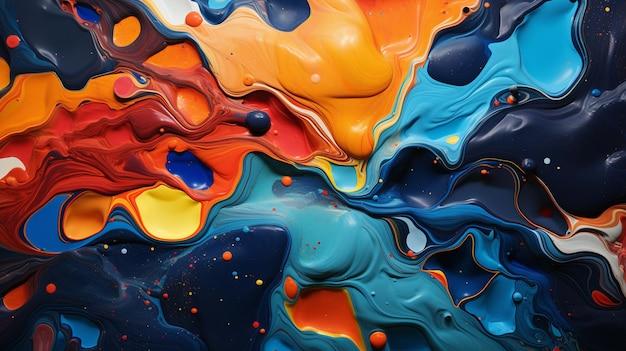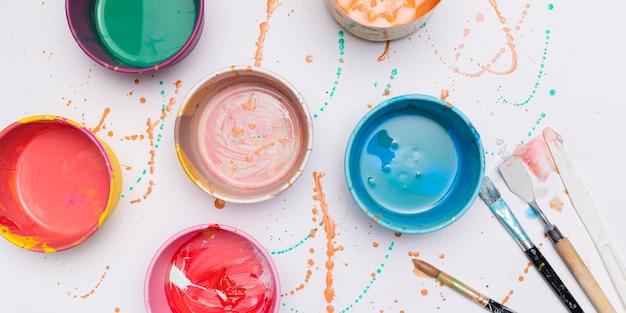Painting can be a daunting task, especially when it comes to mixing paint and diluting it to achieve the desired consistency. If you’ve ever come across the term “4 to 1 paint mix” and wondered what it means, you’re in the right place. In this comprehensive guide, we will dive into the world of paint ratios, specifically focusing on the 4 to 1 ratio and its significance in the painting process.
Whether you’re a professional painter or a DIY enthusiast, understanding paint mix ratios is essential for achieving optimal results. We’ll cover topics such as how to calculate dilution ratios, the importance of paint thinner, mixing base coat, and even the longevity of waiting for clear coat after painting. By the end of this guide, you’ll have a solid grasp on the 4 to 1 paint mix and be well-equipped to tackle your next painting project with confidence. So, let’s get started!

What is a 4 to 1 Paint Mix?
If you’ve ever watched a DIY painting tutorial or tried your hand at a painting project, you might have come across the term “4 to 1 paint mix.” But what does it mean? Is it some secret formula known only to the painting gods? Fear not, my friend, because I’m here to demystify this enigmatic phrase for you.
Understanding the Ratio
In the world of painting, a 4 to 1 mix refers to the ratio of paint to thinner or hardener. Instead of using exact measurements like cups or ounces, the 4 to 1 ratio simplifies things by emphasizing the proportion of ingredients. So, for every four parts of paint, you’ll need to add one part of thinner or hardener. Simple enough, right?
Pro Tips for Achieving the Perfect Mix
Now that you know the basics, let’s dive into some tips and tricks to help you achieve the perfect 4 to 1 paint mix:
1. Choose the Right Thinner or Hardener
The success of your painting project largely depends on using the correct thinner or hardener. Different types of paints require specific thinners or hardeners, so make sure to consult the manufacturer’s instructions or seek expert advice. Using the wrong one might result in a less-than-ideal finish or even lead to paint failure. We certainly don’t want that!
2. Measure Your Ingredients Accurately
While the 4 to 1 ratio is convenient, accuracy is still crucial. Invest in a measuring cup or a mixing stick with clear markings to ensure precise measurements. Remember, just a slight deviation from the recommended ratio can affect the paint’s consistency and its ability to adhere properly.
3. Mix Thoroughly
Once you’ve combined the paint and thinner or hardener, grab a stir stick and mix it thoroughly. The key here is to achieve a smooth and consistent mix. Take your time, be patient, and stir with purpose. Trust me, you don’t want any clumps or inconsistencies ruining your paint job.
4. Test, Test, Test!
Before diving headfirst into your actual painting project, it’s always wise to do a test patch. Apply the mixed paint onto a small, inconspicuous area to evaluate its finish, coverage, and drying time. This way, you can make any necessary adjustments before committing to your main surface.
So, there you have it! A 4 to 1 paint mix demystified and ready for you to conquer. Just remember to choose the right thinner or hardener, measure accurately, mix thoroughly, and don’t forget to test it out. With these tips in your creative arsenal, your painting projects are bound to have that professional touch. Happy painting, my friend!

FAQ: What is a 4 to 1 Paint Mix?
Welcome to another informative and entertaining blog post where we’ll delve into the fascinating world of paint mixing ratios. Whether you’re a professional painter or a DIY enthusiast, understanding the ins and outs of paint mixing is essential for achieving those flawless finishes. In this FAQ-style guide, we’ll address some common questions and demystify the 4 to 1 paint mix ratio. So, let’s get those creative gears turning and dive right in!
What is the Percentage of 4 to 1
The 4 to 1 paint mix ratio refers to the proportion of paint components used in the mix. Specifically, it means that you’ll need four parts of paint to be mixed with one part of another component, such as thinner or a clear coat. Mathematically, this ratio translates to approximately 80% paint and 20% additional component.
How do You Calculate a Dilution Ratio
Calculating a dilution ratio might sound daunting, but fear not! It’s actually quite straightforward. To determine the dilution ratio, simply divide the total volume of the mixed solution by the volume of the paint. For example, if you mix 4 ounces of paint with 1 ounce of thinner, your dilution ratio would be 4:1.
Can You Mix Clear Coat and Paint Together
Absolutely! Mixing clear coat and paint together is a common practice in the automotive industry, especially when you’re aiming for a glossy and durable finish. Just remember to follow the specified ratios and compatibility guidelines provided by the paint manufacturer for best results.
What is the Ratio for Mixing Auto Paint
When it comes to mixing auto paint, there isn’t a one-size-fits-all answer. The mixing ratio can vary depending on factors such as the type of paint, temperature, and application method. However, a commonly used ratio for auto paint mixing is 4 parts paint to 1 part hardener or catalyst.
How do You Calculate Mixing Volume Ratio
To calculate the mixing volume ratio, you’ll need to consider the specific volume measurements for each component. For example, if you have 400 milliliters of paint and you want to achieve a 4 to 1 ratio, you would need 100 milliliters of the other component (e.g., thinner or hardener).
How Long Should You Wait to Clear Coat After Painting
Patience is a virtue, my friend! After painting, it’s crucial to allow the paint to fully cure before applying a clear coat. Generally, it’s recommended to wait at least 24 to 48 hours, allowing enough time for the paint to dry completely. However, always refer to the manufacturer’s guidelines for accurate curing times.
What is a 4 to 1 Ratio in Calibration
In the context of calibration, a 4 to 1 ratio refers to a specific calibration protocol where four calibration points are used for every one measurement point. This helps ensure accuracy and reliability in various measurement systems, from scientific instruments to industrial equipment.
Is Paint Thinner Necessary
Paint thinner can be a handy companion in your paint mixing endeavors, but it’s not always necessary. Its main purpose is to reduce the viscosity of the paint, making it easier to apply and achieving smoother finishes. However, some paints are already formulated with an ideal consistency, eliminating the need for additional thinners.
What Ratio do You Mix Base Coat
When it comes to mixing base coat, there isn’t a fixed ratio that applies universally. The mixing ratio for base coat can vary depending on the specific paint system you’re using. Always refer to the instructions provided by the manufacturer to achieve the best results for your particular base coat.
What Does 4 to 1 Mixture Mean
A 4 to 1 mixture means combining four parts of a particular component with one part of another component, following the specified ratio. This ensures the right balance and compatibility of the mixture components, leading to the desired outcome in terms of color, consistency, and performance.
Why Do We Mix Paint with Thinner
Mixing paint with a thinner serves several purposes. It helps adjust the viscosity or thickness of the paint, making it more manageable and easier to apply. Additionally, thinners can enhance the flow and leveling properties of the paint, resulting in a smooth and professional-looking finish.
What is a 1 to 4 Dilution
A 1 to 4 dilution, also known as a fourfold dilution, means adding one part of a substance to four parts of a solvent or diluent. This ratio is often used when preparing solutions or mixtures that require controlled concentration reductions.
How do You Calculate a Ratio
Calculating ratios is a breeze! To determine a ratio, you simply compare the relative quantities of two or more components. For example, a 4 to 1 ratio means that for every 4 units of one component, you have 1 unit of another component.
What Do You Mean by Mixing Ratio
A mixing ratio refers to the proportion or ratio of different components used when combining substances or materials. This ratio ensures the correct blend and balance of components to achieve the desired properties, performance, and quality in the final mixture.
Do You Put Hardener in Basecoat
Generally, hardeners are not used in basecoats. Basecoats are formulated to be compatible with clear coats, which contain hardeners. The clear coat provides the protective and glossy layer, while the base coat contributes to the color and visual appeal of the painted surface.
How Much Thinner do I Mix with Paint
The amount of thinner you mix with paint depends on various factors, including the desired consistency, type of paint, and application method. As a general guideline, start with a smaller amount and gradually increase until you achieve the desired flow and ease of application. Remember: it’s always easier to add more thinner than to fix an over-thinned mixture!
Why Do Painters Add Water to Paint
While adding water to paint is not as common as adding thinner, it can serve a similar purpose of adjusting the paint’s viscosity. Some water-based paints can be thinned with water to achieve a smoother application and improve coverage. However, always refer to the manufacturer’s recommendations to ensure compatibility and avoid compromising the paint’s quality.
So there you have it – a comprehensive FAQ on the 4 to 1 paint mix ratio! We hope this guide has clarified any uncertainties you may have had and armed you with the knowledge to create stunning finishes. Remember, practice makes perfect, so don’t be afraid to experiment and find the perfect mix for your projects. Happy painting!